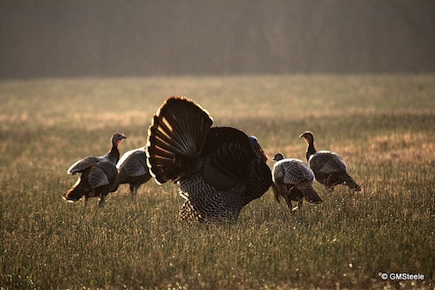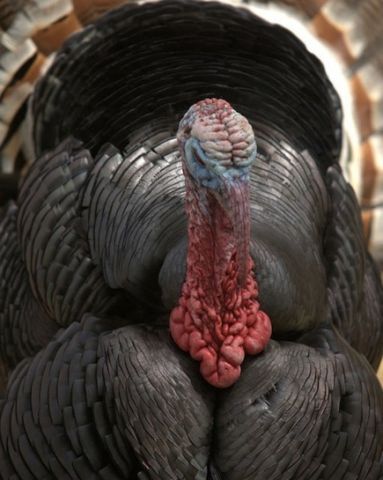Perhaps one of my favorite spring rituals is that of having my camera and photographing wild turkey gobblers as they strut, pose and show off, all in hopes of garnering some quiet little hen’s attention. Stalking and capturing the wild turkey in a viewfinder isn’t as different from stalking and capturing a wild turkey in your gun or bow sites.
During my recent trip to the National Wild Turkey Convention, I had the opportunity to attend The Women’s Outdoor News-sponsored “Outdoor Photography for Women” workshop held by Kathy Butt, photojournalist with Wildlife Taxidermy and Elks Outfitting Services. Kathy’s gorgeous slideshow – filled with superb images of wild turkeys, along with her “tricks of the trade” – left me inspired and longing to hit the woods again this spring in search of the gobblers.
First – find the turkeys! Talk with public land site managers, Conservation Police Officers, game wardens, area farmers; these are all good resources for helping you to locate the elusive wild turkey. This is also a good opportunity to help cement your relationship with these great resource folks, and gain permission for access to any non-public area you may be wishing to set up your equipment to photograph the spring show. Often times public lands such as state parks and national wildlife refuges hold good populations of turkeys (populations that have become somewhat acclimated to a human presence, making your job easier).
Spend a few days scouting and determining the best place to set up. It’s often hard to catch turkeys in a drive-by photo trip, and they frequently require selecting blind or hide site, that you will be slipping into in the wee hours before dawn.
 Once you have determined that turkeys are present, scout the area for a suitable place to set up a blind or to hide. I’m personally not a big fan of commercial blinds. Turkeys have always seemed to be a giant nervous system on legs to me, and often they will bust a commercial blind or hide and run gobbling and yelping the other direction. If you choose to use one of the commercial blinds, add a little natural vegetation around it to assist in helping it to blend in with the surroundings.
Once you have determined that turkeys are present, scout the area for a suitable place to set up a blind or to hide. I’m personally not a big fan of commercial blinds. Turkeys have always seemed to be a giant nervous system on legs to me, and often they will bust a commercial blind or hide and run gobbling and yelping the other direction. If you choose to use one of the commercial blinds, add a little natural vegetation around it to assist in helping it to blend in with the surroundings.
 After I’ve determined where the turkeys are roosting, I look for a spot that offers a wide angle of view, usually in a tree line at the edge of an agricultural field or clearing in the woods. Using natural materials (be sure to make sure you are legally able to trim or move brush, limbs, etc., at your selected site), I build up a small hiding area the day before I plan to photograph. I double check camera placement, insuring that there are no stray sticks, limbs, grasses in the general field of view and that the lighting will be appropriate for both morning and afternoon shooting. The best times for photographing are as always, those golden hours at sunrise and sunset.
After I’ve determined where the turkeys are roosting, I look for a spot that offers a wide angle of view, usually in a tree line at the edge of an agricultural field or clearing in the woods. Using natural materials (be sure to make sure you are legally able to trim or move brush, limbs, etc., at your selected site), I build up a small hiding area the day before I plan to photograph. I double check camera placement, insuring that there are no stray sticks, limbs, grasses in the general field of view and that the lighting will be appropriate for both morning and afternoon shooting. The best times for photographing are as always, those golden hours at sunrise and sunset.
Once I’m happy with my hiding spot, I double-check my equipment for the next day’s journey. First and foremost, I need a long focal length lens: at least a 300mm, and in my case I normally use a 400mm. This offers me the ability to fill the frame without being close enough to spook the turkeys. A sturdy tripod is a must – although I must admit I am not a fan of tripods and rarely use one. After years of hand holding long, heavy focal-length lenses, and developing a system for using my body as tripod, I can work better sans tripod. However, for the average shooter using a long focal length lens, I still recommend a tripod.
Camouflage is important in hiding from those eagle-eyed gobblers, so pack a face mask, camo covers for the camera and camo gloves. My goal is for those strutters to never see me.
Yes, I use all the same items that are familiar to a spring turkey hunter: padded seat cushion/chair for the long sits required, a mouth call, decoys, tick repellent.
Please do not forget to adequately prepare for the onslaught of ticks, mites and other assorted creeping and crawling pests you will encounter. No turkey image is worth a case of Lyme Disease or Rocky Mountain Spotted Fever.
Once I’m satisfied I have all my gear, I troop off to the spring woods in the early predawn hours, so that I’m settled and ready for the early morning fly down. Then the waiting begins.
When the first birds begin to fly down and work across my field of view, I’ll call a teeny bit. I use a mouth call, because it leaves my hands free to operate the camera. While I’m waiting patiently for the turkeys to come into a closer range, I’ll shoot a few test images of the decoys I’ve placed to check exposures, white balance and my settings in general. I tend to use an f-stop of either 5.6 of 8 to insure that the subjects are in sharp focus, but yet the background will be slightly out of focus. I will go as low as a 1/25 shutter speed, but tend to bump them a little higher when the action starts getting hot and the gobblers are strutting, posing and carrying on. I am especially fond of freezing a turkey mid jump.
As tempting as it is to begin snapping as the birds approach your decoy – DON”T – those overly alert fiends will hear that shutter snap and make a run for it. Wait … wait … wait … until they are committed to the decoy, fully involved in their courtship displays. Wait until they aren’t going to be noticing the quiet click, click, click of the shutter.
Not only can you capture the beauty of the wild turkey in a glorious spring woods, you may well also be treated to deer, coyotes, bobcats and other manner of wildlife as you sit quietly in your blind. Pack plenty of memory cards and be prepared to take advantage of these photo opportunities as well.
One last word of advice – don’t forget to pack your mushroom sack, because spring gobblers and tasty morels go hand in hand; keep your eyes open as you trek in and out of the spring turkey woods. What could be better than to head home with a card full of great strutter images and sack full of morels?
This Retro WON first appeared on March 2012.
Gretchen, the tips were great and the photos were amazing!! I’ve been stepping out on our deck pre-dawn, but haven’t heard the turkeys yet. I’m sure it’ll be any day now. Can’t wait!!!
THESE photos have my GANDER up….Woo Hoo! Great writing, Gretchen!
Once again…Gretchen writes an amazing post! Great tips and awesome photos, Gretchen!!
Great work as always Gretchen and thank you for the tips!
Thanks for sharing, great article. Can’t wait to get out there and find them Gobblers.
Beautiful shots! I especially love that backlit first one!